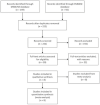Rectal Hypersensitivity in Inflammatory Bowel Disease: A Systematic Review and Meta-analysis
- PMID: 36776657
- PMCID: PMC9802320
- DOI: 10.1093/crocol/otab041
Rectal Hypersensitivity in Inflammatory Bowel Disease: A Systematic Review and Meta-analysis
Abstract
Abdominal pain is a key symptom of inflammatory bowel disease (IBD), particularly in active IBD, but also occurs in patients with quiescent disease suggesting that mechanisms other than active inflammation may be responsible. Putative hypothesis to explain chronic abdominal pain in patients with quiescent IBD includes crossover with irritable bowel syndrome where rectal hypersensitivity is common and has pathophysiological implications. In contrast, in IBD, the role of rectal hypersensitivity has not been established. We aimed to determine if rectal hypersensitivity was more common in IBD compared to a healthy control population. We searched MEDLINE and EMBASE databases (1970-2018). Prospective studies that measured pain/discomfort thresholds to mechanical rectal stimuli in IBD and healthy controls were included. Data were pooled for meta-analysis and effect sizes were calculated with 95% confidence intervals (CIs). Our search strategy identified 222 citations of which 8 met the inclusion criteria, covering 133 individuals with IBD (67 men), aged between 10 and 77 compared to 99 healthy controls (55 men), aged between 10 and 67. The prevalence of rectal hypersensitivity in IBD compared to healthy controls was similar with an effect size of 0.59 (95% CIs: -0.27 to 1.44, P = .16, I 2 = 87.3%). Subgroup analysis did show a significant effect size for patients compared to healthy controls with active disease (1.32) but not for quiescent disease (-0.02). These results suggest that reduced rectal pain thresholds to experimental stimulation are not seen in IBD populations except during active flares of the disease. Further research is required to understand the pathophysiology of chronic abdominal pain in quiescent IBD populations with and without chronic abdominal pain to identify appropriate management strategies.
Keywords: IBD–IBS crossover; abdominal pain; inflammatory bowel disease; rectal hypersensitivity.
© The Author(s) 2021. Published by Oxford University Press on behalf of Crohn's & Colitis Foundation.
Figures
Similar articles
-
Expression of the TRPV1 receptor differs in quiescent inflammatory bowel disease with or without abdominal pain.Gut. 2010 Jun;59(6):767-74. doi: 10.1136/gut.2009.194449. Gut. 2010. PMID: 20551462
-
Methane positive small intestinal bacterial overgrowth in inflammatory bowel disease and irritable bowel syndrome: A systematic review and meta-analysis.Gut Microbes. 2021 Jan-Dec;13(1):1933313. doi: 10.1080/19490976.2021.1933313. Gut Microbes. 2021. PMID: 34190027 Free PMC article.
-
Prevalence of irritable bowel syndrome-type symptoms in patients with inflammatory bowel disease in remission: a systematic review and meta-analysis.Lancet Gastroenterol Hepatol. 2020 Dec;5(12):1053-1062. doi: 10.1016/S2468-1253(20)30300-9. Epub 2020 Oct 2. Lancet Gastroenterol Hepatol. 2020. PMID: 33010814
-
Functional bowel symptoms in quiescent inflammatory bowel diseases: role of epithelial barrier disruption and low-grade inflammation.Gut. 2014 May;63(5):744-52. doi: 10.1136/gutjnl-2012-304066. Epub 2013 Jul 22. Gut. 2014. PMID: 23878165
-
Prevalence of irritable bowel syndrome and functional abdominal pain disorders in children with inflammatory bowel disease in remission.JGH Open. 2022 Nov 3;6(12):818-823. doi: 10.1002/jgh3.12791. eCollection 2022 Dec. JGH Open. 2022. PMID: 36514508 Free PMC article. Review.
Cited by
-
Correlation of Serum CA242, CA724, and TPA Levels with Clinicopathological Features and Prognosis in Patients with Inflammatory Bowel Disease Complicated with Rectal Cancer.J Oncol. 2022 Sep 19;2022:7742760. doi: 10.1155/2022/7742760. eCollection 2022. J Oncol. 2022. PMID: 36245974 Free PMC article.
-
Distinct Alterations in Central Pain Processing of Visceral and Somatic Pain in Quiescent Ulcerative Colitis Compared to Irritable Bowel Syndrome and Health.J Crohns Colitis. 2023 Nov 8;17(10):1639-1651. doi: 10.1093/ecco-jcc/jjad080. J Crohns Colitis. 2023. PMID: 37161902 Free PMC article.
-
Disease-specific alterations in central fear network engagement during acquisition and extinction of conditioned interoceptive fear in inflammatory bowel disease.Mol Psychiatry. 2024 Nov;29(11):3527-3536. doi: 10.1038/s41380-024-02612-7. Epub 2024 May 27. Mol Psychiatry. 2024. PMID: 38802508 Free PMC article.
-
Impact of electro-acupuncture on EAAT2 and NMDAR-2B expression in goats with visceral hypersensitivity.Heliyon. 2024 Dec 2;10(23):e40700. doi: 10.1016/j.heliyon.2024.e40700. eCollection 2024 Dec 15. Heliyon. 2024. PMID: 39717594 Free PMC article.
-
Post-inflammatory Abdominal Pain in Patients with Inflammatory Bowel Disease During Remission: A Comprehensive Review.Crohns Colitis 360. 2021 Nov 8;3(4):otab073. doi: 10.1093/crocol/otab073. eCollection 2021 Oct. Crohns Colitis 360. 2021. PMID: 36777266 Free PMC article. Review.
References
-
- Knowles CH, Aziz Q. Basic and clinical aspects of gastrointestinal pain. Pain. 2009;141(3):191–209. - PubMed
-
- Wilder-Smith OH. Chronic pain and surgery: a review of new insights from sensory testing. J Pain Palliat Care Pharmacother. 2011;25(2):146–159. - PubMed
-
- Albusoda A, Ruffle JK, Friis KA, et al. . Systematic review with meta-analysis: conditioned pain modulation in patients with the irritable bowel syndrome. Aliment Pharmacol Ther. 2018;48(8):797–806. - PubMed
Publication types
LinkOut - more resources
Full Text Sources
Miscellaneous



